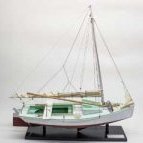-
Posts
355 -
Joined
-
Last visited
Reputation Activity
-
 jhearl got a reaction from EricWilliamMarshall in Bluenose II by Heronguy - Artesania Latina #20500 - Scale 1:75 - 2nd build
jhearl got a reaction from EricWilliamMarshall in Bluenose II by Heronguy - Artesania Latina #20500 - Scale 1:75 - 2nd build
As Mark Twain said, more or less, the rumors or my demise have been greatly exaggerated! Still alive and kicking although a bit more slowly every year. I retired in September of last year and have been enjoying lots more time to work on models. I still maintain the website and am currently working on a scratch build of a Chesapeake Bay buyboat.
Doug - looks like your BN2 is coming along well.
Cheers -
John
-
 jhearl got a reaction from flying_dutchman2 in Where to buy thread for ropewalk machines?
jhearl got a reaction from flying_dutchman2 in Where to buy thread for ropewalk machines?
I have been using DMC Cordonnet thread for years now. It comes in ecru, which works well for un-tarred rope and it can be easily dyed after the rope is made if you want a dark brown. It is a cotton thread but has no fuzz and is considerably less expensive than linen. It comes in sizes 20-100 (100 is smallest). Here's one online US source that appears to carry all sizes:
https://www.tattingcorner.com/threads-12/dmc-cordonnet-67/
(I've never ordered from them and have no affiliation with them in any way - just one source I found on the web.)
Sometimes, even the 100 is too large, so I use Gutermann cotton sewing thread for the smallest lines. Sometimes, you have to just use thread itself without twisting it into rope for really tiny lines. I'm not sure what kind of rope machine you have, but on mine, I can use multiple threads (such as 6 or 9) to get even thicker rope if three 20s aren't big enough, for example. When I got started making rope, I made up a sample length with each thread size so I would know what I needed in the future for a particular size finished rope.
Cheers -
John
-
 jhearl got a reaction from Zocane in Do I Use Primer?
jhearl got a reaction from Zocane in Do I Use Primer?
One advantage to a primer over a clear sanding sealer is that it will show up any defects that need to be repaired before painting the final coats. I always find something that needs to be fixed. On hulls, I usually use something like Rustoleum or Krylon in a rattle can from the hardware store. Of course, it has to be sanded before applying finish coats.
Cheers -
John
-
 jhearl got a reaction from CKNavy in Do I Use Primer?
jhearl got a reaction from CKNavy in Do I Use Primer?
One advantage to a primer over a clear sanding sealer is that it will show up any defects that need to be repaired before painting the final coats. I always find something that needs to be fixed. On hulls, I usually use something like Rustoleum or Krylon in a rattle can from the hardware store. Of course, it has to be sanded before applying finish coats.
Cheers -
John
-
 jhearl got a reaction from thibaultron in Do I Use Primer?
jhearl got a reaction from thibaultron in Do I Use Primer?
One advantage to a primer over a clear sanding sealer is that it will show up any defects that need to be repaired before painting the final coats. I always find something that needs to be fixed. On hulls, I usually use something like Rustoleum or Krylon in a rattle can from the hardware store. Of course, it has to be sanded before applying finish coats.
Cheers -
John
-
 jhearl got a reaction from Canute in Do I Use Primer?
jhearl got a reaction from Canute in Do I Use Primer?
One advantage to a primer over a clear sanding sealer is that it will show up any defects that need to be repaired before painting the final coats. I always find something that needs to be fixed. On hulls, I usually use something like Rustoleum or Krylon in a rattle can from the hardware store. Of course, it has to be sanded before applying finish coats.
Cheers -
John
-
 jhearl got a reaction from GuntherMT in tutorial project: turning a brass scribe - by Clickspring
jhearl got a reaction from GuntherMT in tutorial project: turning a brass scribe - by Clickspring
I've watched all of his videos in the past and that guy is just amazing. Highly recommended!
Cheers -
John
-
 jhearl got a reaction from bluenose2 in Deck planking
jhearl got a reaction from bluenose2 in Deck planking
That's too bad that poplar isn't available in Canada. I'm no fan of aspen. I got some by mistake once when I was buying poplar and didn't like it at all.
-
 jhearl got a reaction from mtaylor in Easiest to plank
jhearl got a reaction from mtaylor in Easiest to plank
The Ronnberg book mentioned above is included in the kit you have, so there would be no need to buy another copy if that's the one you're thinking of.
Cheers -
John
-
 jhearl got a reaction from mtaylor in Deck planking
jhearl got a reaction from mtaylor in Deck planking
That's too bad that poplar isn't available in Canada. I'm no fan of aspen. I got some by mistake once when I was buying poplar and didn't like it at all.
-
 jhearl got a reaction from Canute in Easiest to plank
jhearl got a reaction from Canute in Easiest to plank
The Ronnberg book mentioned above is included in the kit you have, so there would be no need to buy another copy if that's the one you're thinking of.
Cheers -
John
-
 jhearl got a reaction from MikeB4 in Easiest to plank
jhearl got a reaction from MikeB4 in Easiest to plank
The Ronnberg book mentioned above is included in the kit you have, so there would be no need to buy another copy if that's the one you're thinking of.
Cheers -
John
-
 jhearl got a reaction from bluenose2 in Deck planking
jhearl got a reaction from bluenose2 in Deck planking
I second the suggestion on poplar. It's not hard to find pieces without any green. It's very easy to work with and is harder than ordinary building pine. It has a fine grain and machines well. It's inexpensive and is readily available in 3/4" thick boards, which makes it easy to turn into ship modeling lumber. In some of the large lumber stores, you can also find boards in 1/4" and 1/2" thicknesses that are typically 3"x24" and often they are very white and almost grain free. I've used poplar on several models and like it a lot. At the moment, I'm using it to plank the outside of a deckhouse and the planks are 3mm wide and less than 1mm thick.
Cheers -
John
-
 jhearl got a reaction from mtaylor in Deck planking
jhearl got a reaction from mtaylor in Deck planking
I second the suggestion on poplar. It's not hard to find pieces without any green. It's very easy to work with and is harder than ordinary building pine. It has a fine grain and machines well. It's inexpensive and is readily available in 3/4" thick boards, which makes it easy to turn into ship modeling lumber. In some of the large lumber stores, you can also find boards in 1/4" and 1/2" thicknesses that are typically 3"x24" and often they are very white and almost grain free. I've used poplar on several models and like it a lot. At the moment, I'm using it to plank the outside of a deckhouse and the planks are 3mm wide and less than 1mm thick.
Cheers -
John
-
 jhearl got a reaction from Heronguy in Deck planking
jhearl got a reaction from Heronguy in Deck planking
I second the suggestion on poplar. It's not hard to find pieces without any green. It's very easy to work with and is harder than ordinary building pine. It has a fine grain and machines well. It's inexpensive and is readily available in 3/4" thick boards, which makes it easy to turn into ship modeling lumber. In some of the large lumber stores, you can also find boards in 1/4" and 1/2" thicknesses that are typically 3"x24" and often they are very white and almost grain free. I've used poplar on several models and like it a lot. At the moment, I'm using it to plank the outside of a deckhouse and the planks are 3mm wide and less than 1mm thick.
Cheers -
John
-
 jhearl got a reaction from mtaylor in I will purchase model shipways New Bedford whale boat plans MS2033
jhearl got a reaction from mtaylor in I will purchase model shipways New Bedford whale boat plans MS2033
Are you aware that you can purchase the plans directly from Model Expo?
http://www.modelexpo-online.com/product.asp?ITEMNO=MSPL2033
Cheers -
John
-
 jhearl got a reaction from CKNavy in Bluenose II by CKNavy - Artesania Latina - Scale 1:75 - First Wooden Ship Build
jhearl got a reaction from CKNavy in Bluenose II by CKNavy - Artesania Latina - Scale 1:75 - First Wooden Ship Build
You can find the articles here - http://modelboatyard.com/bluenose2_articles.html
Cheers -
John
-
 jhearl got a reaction from thibaultron in tutorial project: turning a brass scribe - by Clickspring
jhearl got a reaction from thibaultron in tutorial project: turning a brass scribe - by Clickspring
I've watched all of his videos in the past and that guy is just amazing. Highly recommended!
Cheers -
John
-
 jhearl got a reaction from russ in Looking for a kit
jhearl got a reaction from russ in Looking for a kit
The most challenging (and rewarding) part about building from scratch is that there are no instructions. You have to figure out what to do, when to do it, and how to do it. You have to think far ahead to understand how something you do now might affect what you need to do in the future. The best plans in the world won't help with that. Having experience in building kits is helpful, of course, but you may be surprised at just how different the experience is when you have to go it alone just from a set of plans. If you want to try scratch building, I'd suggest starting with a very simple boat so you can really get a feel for what it takes. Don't forget as well, that you won't have any pre-cut parts. You're bound to need dimensioned lumber that isn't available unless you can mill it yourself. Scratch building is great fun and highly rewarding, but it's certainly not easy.
Cheers -
John
-
 jhearl got a reaction from Canute in tutorial project: turning a brass scribe - by Clickspring
jhearl got a reaction from Canute in tutorial project: turning a brass scribe - by Clickspring
I've watched all of his videos in the past and that guy is just amazing. Highly recommended!
Cheers -
John
-
 jhearl got a reaction from mtaylor in Looking for a kit
jhearl got a reaction from mtaylor in Looking for a kit
The most challenging (and rewarding) part about building from scratch is that there are no instructions. You have to figure out what to do, when to do it, and how to do it. You have to think far ahead to understand how something you do now might affect what you need to do in the future. The best plans in the world won't help with that. Having experience in building kits is helpful, of course, but you may be surprised at just how different the experience is when you have to go it alone just from a set of plans. If you want to try scratch building, I'd suggest starting with a very simple boat so you can really get a feel for what it takes. Don't forget as well, that you won't have any pre-cut parts. You're bound to need dimensioned lumber that isn't available unless you can mill it yourself. Scratch building is great fun and highly rewarding, but it's certainly not easy.
Cheers -
John
-
 jhearl got a reaction from mtaylor in tutorial project: turning a brass scribe - by Clickspring
jhearl got a reaction from mtaylor in tutorial project: turning a brass scribe - by Clickspring
I've watched all of his videos in the past and that guy is just amazing. Highly recommended!
Cheers -
John
-
 jhearl got a reaction from WackoWolf in tutorial project: turning a brass scribe - by Clickspring
jhearl got a reaction from WackoWolf in tutorial project: turning a brass scribe - by Clickspring
I've watched all of his videos in the past and that guy is just amazing. Highly recommended!
Cheers -
John
-
 jhearl got a reaction from Ryland Craze in Looking for a kit
jhearl got a reaction from Ryland Craze in Looking for a kit
The most challenging (and rewarding) part about building from scratch is that there are no instructions. You have to figure out what to do, when to do it, and how to do it. You have to think far ahead to understand how something you do now might affect what you need to do in the future. The best plans in the world won't help with that. Having experience in building kits is helpful, of course, but you may be surprised at just how different the experience is when you have to go it alone just from a set of plans. If you want to try scratch building, I'd suggest starting with a very simple boat so you can really get a feel for what it takes. Don't forget as well, that you won't have any pre-cut parts. You're bound to need dimensioned lumber that isn't available unless you can mill it yourself. Scratch building is great fun and highly rewarding, but it's certainly not easy.
Cheers -
John
-
 jhearl got a reaction from Nirvana in Bluenose II by Bulwark - Artesania Latina - Scale 1:75
jhearl got a reaction from Nirvana in Bluenose II by Bulwark - Artesania Latina - Scale 1:75
As Doug says, the planking batten is just a guide - not an absolute. When you fair the bulkheads, you might take off more or less material than someone else building the same model so your measurement from keel to deck along any given bulkhead could be slightly different. The key with this and perhaps most other models is that you want all the planks at the widest part of the ship to be about the same width (mostly because it looks nicer). It doesn't matter what that exact width is. For example, if when you measure along the outside of the bulkhead you determine it is 75mm from deck to keel (assuming that's the area you plan to cover - I'm not referring to this model specifically) and you want to use 15 planks, then each plank needs to be 5mm wide at that bulkhead. If you decided you wanted to cover that space with 17 planks, then each plank would have to be about 4.4mm wide at that bulkhead. The number of planks you use is up to you. Of course, if you want to make a realistic model, you might not choose to use planks that would be 3 feet wide on a real ship! And, as with any rule, there are always exceptions. The garboard plank, for instance, could be wider than the rest of the planks. That's not the case on this particular model, however. As you measure plank widths for other bulkheads, the width of the plank will change since the overall space to cover is less on the other bulkheads, but you want to strive, again, to have all of the planks on any given bulkhead to be the same width. In your last pic above, that final plank next to the batten concerns me a little because it seems way too narrow at the ends. It may, however, just appear that way in the photo. Still, I'd take a look at that before going further. You may need to re-do that one. Overall though, it seems to be coming along just fine.
By the way - I heartily agree with the suggestion to just buy basswood if you need more planking material. There's no point in buying expensive boxwood - especially if you plan to paint the hull.
Cheers -
John



.thumb.jpeg.fc5d633a7b34428fcf19419a73d56d55.jpeg)











